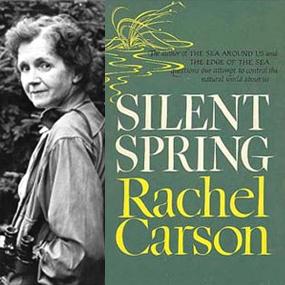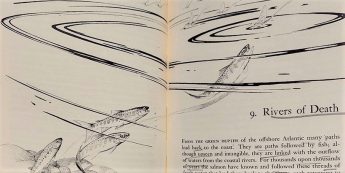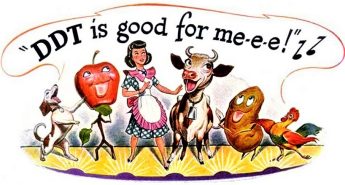Silent Spring Celebration…

Silent Spring: 50 Years & Counting – Silent Spring Summary
It doesn’t seem like 50 years ago that I first took Rachel Carson’s “Silent Spring” out of the school library. It was an education in itself — a look at what our industrial society was doing to our living world. It was a shocking read for one so young. Especially back in the innocent Sixties.
Today, we try to buy organic veggies — in fact we grow our own. Agrobiz talks about “organic pesticides,” whatever they are.
“Silent Spring” was a dreadful look at the future, more profound than Orwell’s.
Fifty years ago this month, Rachel Carson released her seminal work, “Silent Spring.” The publication of this book began the most significant environmental movement ever seen in the US.
Carson warned of future health problems due to organophosphate pesticides, substances first developed as chemical nerve gas weapons around the time of WWII, which today amass to over 2.5 million tons sold annually. Globally, pesticide exposure is a common source of acute poisoning with an estimated 25 million poisonings and 200,000 deaths in the developing world each year. Equally concerning are the chronic effects of pesticide exposure.
At the time of her writing, Carson had documented the adverse effects of pesticides in the ecosystems of birds, fish and other animals. Carson interpreted the use of pesticides as a chemical war against nature. “Man is a part of nature … his war against nature is inevitably a war against himself.”

Pesticide residues remain on food and are often resistant to washing. Following the ingestion of pesticide contaminated food, the pesticides store in human fat, and the brain, often for long periods of time. Recently, the CDC began to measure these chemical residues left in the body, and found 13 different pesticides in the urine or blood serum of over 70% of Americans (including children).
What makes pesticide residues retained in the body so concerning, is their possible linkage to many varied health problems including childhood cancers, leukemia, breast cancer, lymphoma, diabetes, obesity, Parkinson’s disease, birth defects, autism, and infertility. Dr. Carson commented in Silent Spring, “It is ironic to think that man might determine his own future by something as seemingly trivial as the choice of an insect spray.”
Industry struck back with an info-barrage, believing that most adults were “too scientifically unaware” to understand Rachel’s book…

Eight years after the publication of “Silent Spring,” and to some extent in response to “Silent Spring,” President Richard Nixon boldly established the US Environmental Protection Agency (EPA).
Shortly after its formation, the EPA banned DDT, the major culprit Dr. Carson highlighted in her book. The EPA was convinced by Dr. Carson’s argument that the domestic use of DDT posed unacceptable risks to the environment and potential harm to human health.
Other nations followed the EPA’s lead, including Canada.
Unfortunately, the export of the toxicant to developing countries was still deemed acceptable and continues to this day. Scientists have since learned that atmospheric wind patterns often bring this banned substance back into our backyard.
The ubiquitous usage and easy availability of pesticides to consumers suggests a measure of safety that is often untrue. Unfortunately, proving safety is not required before a pesticide is allowed to reach the market. When it comes to pesticides, history teaches us that what is sought is evidence of harm years and often decades after product introduction. Only then, and often with significant industry resistance is a ban on a harmful pesticide imposed.
Dr. Carson endorsed a philosophy that is today called the precautionary principle. This principle places the burden of “proof of harmlessness” onto the manufacturer. Carson believed that precautionary principles should be imposed when harm was suspected even without definitive proof; plausibility of harm was itself sufficient to keep a product off the market.
Outside the US, the ideas behind the precautionary principles are accepted and in fact, such principles are explicitly incorporated into The Maastricht Treaty of the European Union in 1992.
Today, the precautionary principle could not be more relevant as local health authorities weigh the risks and benefits of spraying pesticides over local communities in order to diminish mosquito populations that carry concerning infectious diseases.
These vectors are anticipated to become an increasing problem as global warming changes the survival characteristics of mosquitos. Illnesses due to the West Nile virus, Dengue, and perhaps Malaria are predicted to increase in the United States.
Should our approach to these potential problems rely upon airplanes spraying pesticides onto our communities?
While newer classes of pesticides are likely less toxic to humans than those banned in prior years, all pesticides have adverse effects on ecology and aquatic life and effects on human health cannot be ruled out. For example, several epidemiological studies now suggest that exposure to a class of presumably safer pesticides (Pyrethroids) may in fact have adverse effects on the intellectual development of children.
If alive today, Carson would likely continue to question the wisdom of the unbridled usage of pesticides. She would likely continue to insist that society find more sensible alternatives.
“Live Free, Mon Ami!” – Brian Alan Burhoe
AUTHORS:
- Eric Hecht MD, MSPH is a voluntary associate professor in the department of epidemiology at the Miller School of Medicine at the University of Miami.
- Yasmin Dias-Guichot MS obtained her master’s degree in public health at the University of Miami.
- Brian Alan Burhoe is a writer of hundreds of online articles and the creator of the Civilized Bears.
See my TABLET & CELL PHONE FRIENDLY Format: BrianAlanBurhoe.com
Keywords: animal rights, canada environment, carson silent spring, ddt, living environment, organic pesticides, pesticide, the environment, the silent spring, silent spring summary.












